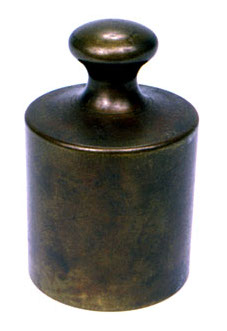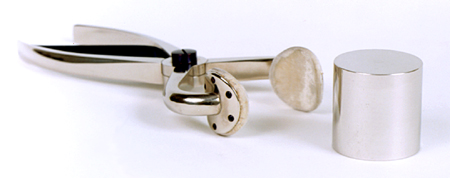Grave (unit) on:
[Wikipedia]
[Google]
[Amazon]
 The grave (, ), abbreviated ''gv'', is the unit of mass used in the first
The grave (, ), abbreviated ''gv'', is the unit of mass used in the first
 After the definitions were finalized in 1799, an all-platinum kilogram prototype was fabricated with the objective that it would equal, as close as was scientifically feasible for the day, the mass of one cubic decimetre of water at 4°C.
It was called the ''Kilogramme des Archives'' as it was stored in the Archives Nationales in Paris. The prototype was presented to the Archives of the Republic in June, and on 10 December 1799, the prototype was formally ratified as the ''Kilogramme des Archives'' (Kilogram of the Archives)
After the definitions were finalized in 1799, an all-platinum kilogram prototype was fabricated with the objective that it would equal, as close as was scientifically feasible for the day, the mass of one cubic decimetre of water at 4°C.
It was called the ''Kilogramme des Archives'' as it was stored in the Archives Nationales in Paris. The prototype was presented to the Archives of the Republic in June, and on 10 December 1799, the prototype was formally ratified as the ''Kilogramme des Archives'' (Kilogram of the Archives)Armoire de fer
, (in English: Iron chest), vault built in 1790 and used to store kilogram and metre prototypes and the kilogram was defined as being equal to its mass. This standard stood for the next ninety years, until being replaced in 1889 by the platinum–iridium
 The grave (, ), abbreviated ''gv'', is the unit of mass used in the first
The grave (, ), abbreviated ''gv'', is the unit of mass used in the first metric system
The metric system is a system of measurement that standardization, standardizes a set of base units and a nomenclature for describing relatively large and small quantities via decimal-based multiplicative unit prefixes. Though the rules gover ...
, which was implemented in France
France, officially the French Republic, is a country located primarily in Western Europe. Overseas France, Its overseas regions and territories include French Guiana in South America, Saint Pierre and Miquelon in the Atlantic Ocean#North Atlan ...
in 1793. In 1795, the grave was renamed as the kilogram
The kilogram (also spelled kilogramme) is the base unit of mass in the International System of Units (SI), equal to one thousand grams. It has the unit symbol kg. The word "kilogram" is formed from the combination of the metric prefix kilo- (m ...
.
Origin
The modern kilogram has its origins in theAge of Enlightenment
The Age of Enlightenment (also the Age of Reason and the Enlightenment) was a Europe, European Intellect, intellectual and Philosophy, philosophical movement active from the late 17th to early 19th century. Chiefly valuing knowledge gained th ...
and the French Revolution. In 1790 an influential proposal by Talleyrand called for a new system of units, including a unit of length derived from an invariable length in nature, and a unit of mass (then called ''weight'') equal to the mass of a unit volume of water. In 1791, the Commission of Weights and Measures, appointed by the French Academy of Sciences, chose one ten-millionth of the half meridian as the unit of length, and named it ''metre
The metre (or meter in US spelling; symbol: m) is the base unit of length in the International System of Units (SI). Since 2019, the metre has been defined as the length of the path travelled by light in vacuum during a time interval of of ...
''. Initially a ''provisional'' value was used, based on the meridian measurement made in 1740 by Lacaille.
In 1793 the commission defined the unit of mass as a cubic decimetre of distilled water at 0 °C, and gave it the name ''grave''. Two supplemental unit names, gravet (0.001 grave), and bar (1000 grave), were added to cover the same range as the old units, resulting in the following decimal series of units: milligravet, centigravet, decigravet, gravet, centigrave, decigrave, grave, centibar, decibar, bar. As measured by the customary unit of mass in use in France at the time, the mass of the new unit volume (1 dm3provisional) of water at 0 °C was determined by Lavoisier and Haüy to be 18841 grain
A grain is a small, hard, dry fruit (caryopsis) – with or without an attached husk, hull layer – harvested for human or animal consumption. A grain crop is a grain-producing plant. The two main types of commercial grain crops are cereals and ...
s.
Since a mass standard made of water would be inconvenient and unstable, the regulation of commerce necessitated the manufacture of a ''practical realisation'' of the water-based definition of mass. Accordingly, a provisional mass standard of the grave was made as a single-piece, metallic artefact.
Transition to the kilogram
On 7 April 1795, thegram
The gram (originally gramme; SI unit symbol g) is a Physical unit, unit of mass in the International System of Units (SI) equal to one thousandth of a kilogram.
Originally defined in 1795 as "the absolute Mass versus weight, weight of a volume ...
was decreed in France to be "the absolute weight of a volume of pure water equal to the cube of the hundredth part of the metre, and at the temperature of melting ice".
The law also replaced the three names gravet, grave and bar by a single generic unit name: the gram. The new gram was equal to the old gravet. Four new prefixes (deca, hecto, kilo, and myria) were added to the metric system to cover almost the same range of units as in 1793 (milligram, centigram, decigram, gram, decagram, hectogram, kilogram, myriagram). The brass prototype of the grave was renamed to provisional kilogram.
In 1799 the provisional units were replaced by the final ones. Delambre and Méchain had completed their new measurement of the meridian, and the final metre was 0.03% smaller than the provisional one. Hence the final kilogram, being the mass of one cubic decimetre of water, was 0.09% lighter than the provisional one. In addition, the temperature specification of the water was changed from 0 °C to the point where the density of water is maximal (about 4 °C). This change of temperature added 0.01% to the final kilogram.
At the same time, work was commissioned to precisely determine the mass of a cubic decimetre (one litre
The litre ( Commonwealth spelling) or liter ( American spelling) (SI symbols L and l, other symbol used: ℓ) is a metric unit of volume. It is equal to 1 cubic decimetre (dm3), 1000 cubic centimetres (cm3) or 0.001 cubic metres (m3). A ...
) of water.
The same decree also defined the litre as follows: "Litre: the measure of volume, both for liquid and solids, for which the displacement would be that of a cube ith sides measuringone-tenth of a metre." Original text: "" Although the decreed definition of the kilogram specified water at 0°C—its highly stable ''temperature'' point—the French chemist Louis Lefèvre-Gineau and the Italian naturalist Giovanni Fabbroni chose to redefine the standard in 1799 to water's most stable ''density'' point: the temperature at which water reaches maximum density, which was measured at the time as 4°C.Modern measurements show the temperature at which water reaches maximum density is 3.984°C. However, the scientists at the close of the 18th century concluded that the temperature was 4°C.
They concluded that one cubic decimetre of water at its maximum density was equal to 99.9265% of the target mass of the provisional kilogram standard made four years earlier.
''Kilogramme des Archives''
 After the definitions were finalized in 1799, an all-platinum kilogram prototype was fabricated with the objective that it would equal, as close as was scientifically feasible for the day, the mass of one cubic decimetre of water at 4°C.
It was called the ''Kilogramme des Archives'' as it was stored in the Archives Nationales in Paris. The prototype was presented to the Archives of the Republic in June, and on 10 December 1799, the prototype was formally ratified as the ''Kilogramme des Archives'' (Kilogram of the Archives)
After the definitions were finalized in 1799, an all-platinum kilogram prototype was fabricated with the objective that it would equal, as close as was scientifically feasible for the day, the mass of one cubic decimetre of water at 4°C.
It was called the ''Kilogramme des Archives'' as it was stored in the Archives Nationales in Paris. The prototype was presented to the Archives of the Republic in June, and on 10 December 1799, the prototype was formally ratified as the ''Kilogramme des Archives'' (Kilogram of the Archives), (in English: Iron chest), vault built in 1790 and used to store kilogram and metre prototypes and the kilogram was defined as being equal to its mass. This standard stood for the next ninety years, until being replaced in 1889 by the platinum–iridium
International Prototype of the Kilogram
The International Prototype of the Kilogram (referred to by metrology, metrologists as the IPK or Le Grand K; sometimes called the ''wiktionary:ur-#Prefix, ur-kilogram'', or ''urkilogram'', particularly by German-language authors writing in Engli ...
(IPK).
See also
*Gram
The gram (originally gramme; SI unit symbol g) is a Physical unit, unit of mass in the International System of Units (SI) equal to one thousandth of a kilogram.
Originally defined in 1795 as "the absolute Mass versus weight, weight of a volume ...
* International System of Units
The International System of Units, internationally known by the abbreviation SI (from French ), is the modern form of the metric system and the world's most widely used system of measurement. It is the only system of measurement with official s ...
(SI)
* Kilogram
The kilogram (also spelled kilogramme) is the base unit of mass in the International System of Units (SI), equal to one thousand grams. It has the unit symbol kg. The word "kilogram" is formed from the combination of the metric prefix kilo- (m ...
* Kilogram-force
The kilogram-force (kgf or kgF), or kilopond (kp, from ), is a non-standard Gravitational metric system, gravitational metric unit of force. It is not accepted for use with the International System of Units (SI) and is deprecated for most uses. T ...
* List of unusual units of measurement
* Mass
Mass is an Intrinsic and extrinsic properties, intrinsic property of a physical body, body. It was traditionally believed to be related to the physical quantity, quantity of matter in a body, until the discovery of the atom and particle physi ...
* Metric prefix
A metric prefix is a unit prefix that precedes a basic unit of measure to indicate a multiple or submultiple of the unit. All metric prefixes used today are decadic. Each prefix has a unique symbol that is prepended to any unit symbol. The pr ...
* Metric system
The metric system is a system of measurement that standardization, standardizes a set of base units and a nomenclature for describing relatively large and small quantities via decimal-based multiplicative unit prefixes. Though the rules gover ...
* SI base unit
The SI base units are the standard units of measurement defined by the International System of Units (SI) for the seven base quantities of what is now known as the International System of Quantities: they are notably a basic set from which al ...
s
* SI derived unit
SI derived units are units of measurement derived from the
seven SI base units specified by the International System of Units (SI). They can be expressed as a product (or ratio) of one or more of the base units, possibly scaled by an appropriat ...
s
References
Notes
{{DEFAULTSORT:Grave (Unit) Non-SI metric units Units of mass